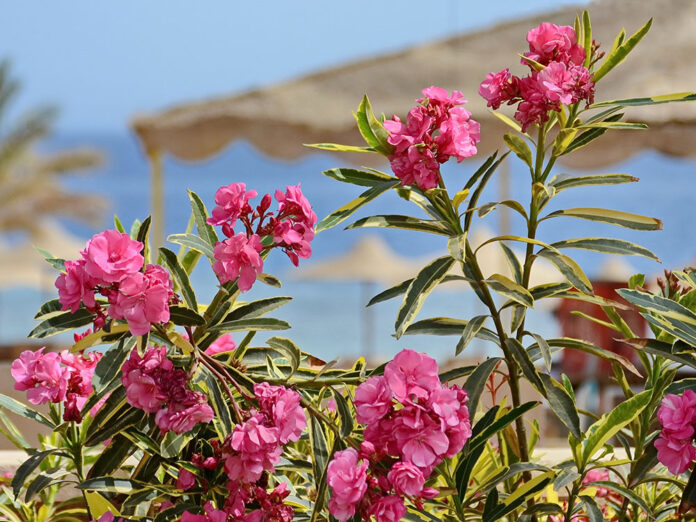
If oleanders are toxic, why do we have so many of them growing in Maricopa? Here’s the scoop on the good, the bad and the ugly aspects of oleanders.
Nerium oleander, often romantically called rose laurel, and its relatives like the desert rose (Adenium) and yellow oleander (Thevetia peruviana) are prized as ornamental and landscape plants. They are fast-growing, drought-tolerant and easy to maintain. They are sun-loving, evergreen, not picky about soil quality and impervious to air pollutants and dry wind.
Their blossoms are beautiful and often very fragrant in colors of pink, white, red, salmon, apricot, yellow and even purple. Oleander can be planted singly as a specimen plant or in groups for a privacy hedge or windbreak. The taller varieties can be trained into lovely, long-blooming trees.
At last count, there are about 500 varieties of oleanders.
Oleanders have a few problems. They can attract aphids, which are easily dispersed with a strong stream of water. Sticky “honeydew” on the leaves or the presence of ants in the plant may indicate aphids. Leaf drop may be the result of either under- or over-watering. Best practice at this time of year is deep watering one or two times weekly, but oleanders do not like soggy roots.
A fairly recent development with oleanders is leaf scorch. This is an infection caused by the Xylella fastidiosa bacterium spread by the glassy winged sharpshooter; it is injected when the sharpshooter feeds on oleander tissues. The uptake of water and nutrients through the roots is interrupted, causing the leaves to yellow and drop. The life of the plant may be prolonged by pruning and destroying (not composting) the affected areas, but there is no cure.
But the beautiful oleander is also treacherous. All parts of the plant: flowers, leaves, stems, trunks, and roots – both dried and green – contain powerful compounds that can cause severe gastric and cardiac distress when ingested. The sap from the plant can cause skin irritation. Even smoke from burning oleander leaves can be irritating.
Humans, cattle, horses, sheep, goats and llamas can all be affected by oleander poisoning. But, luckily, the bitter taste and sharp-pointed leaves make the plant unpalatable, so ingestion by humans is rare.
Symptoms of blurred vision, difficulty breathing, stomach pain and diarrhea, vomiting, low blood pressure, irregular heartbeat, dizziness or drowsiness, disorientation, depression, tremors or severe headache can present about four hours after ingestion. If oleander ingestion is suspected, contact our local emergency services or the National Poison Control Center at 1-800-222-1222.
Master Gardener Rita Bricker has been a resident of Maricopa since 1987.
This column appears in the September issue of InMaricopa magazine.















![Affordable apartments planned near ‘Restaurant Row’ A blue square highlights the area of the proposed affordable housing development and "Restaurant Row" sitting south of city hall and the Maricopa Police Department. Preliminary architectural drawings were not yet available. [City of Maricopa]](https://www.inmaricopa.com/wp-content/uploads/2024/04/041724-affordable-housing-project-restaurant-row-100x70.jpg)

